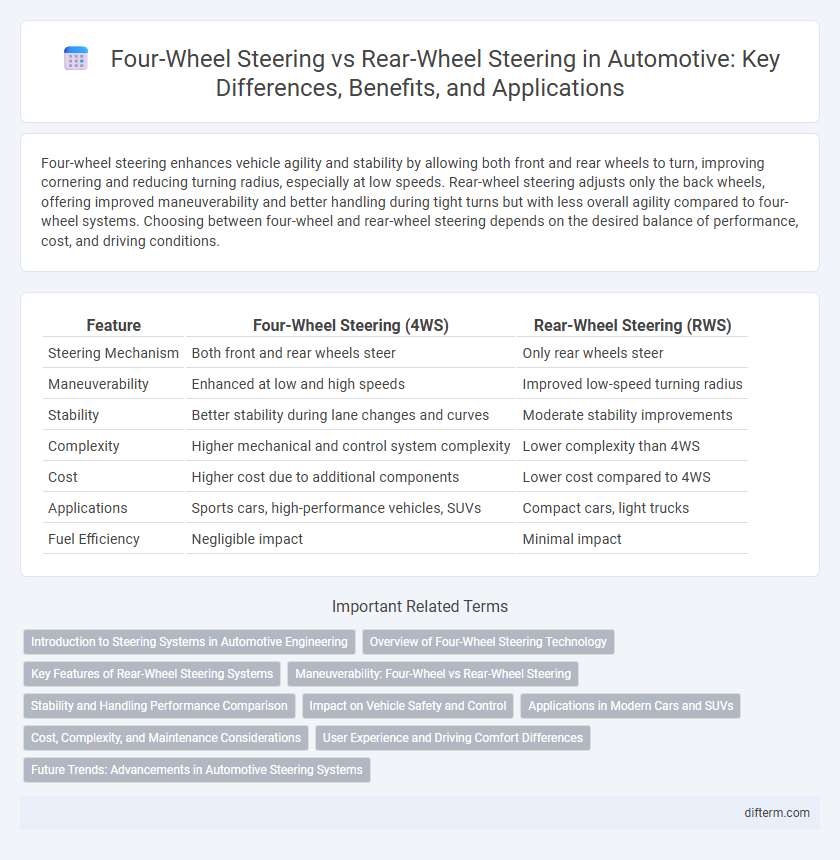Four-wheel steering enhances vehicle agility and stability by allowing both front and rear wheels to turn, improving cornering and reducing turning radius, especially at low speeds. Rear-wheel steering adjusts only the back wheels, offering improved maneuverability and better handling during tight turns but with less overall agility compared to four-wheel systems. Choosing between four-wheel and rear-wheel steering depends on the desired balance of performance, cost, and driving conditions.
Table of Comparison
| Feature | Four-Wheel Steering (4WS) | Rear-Wheel Steering (RWS) |
|---|---|---|
| Steering Mechanism | Both front and rear wheels steer | Only rear wheels steer |
| Maneuverability | Enhanced at low and high speeds | Improved low-speed turning radius |
| Stability | Better stability during lane changes and curves | Moderate stability improvements |
| Complexity | Higher mechanical and control system complexity | Lower complexity than 4WS |
| Cost | Higher cost due to additional components | Lower cost compared to 4WS |
| Applications | Sports cars, high-performance vehicles, SUVs | Compact cars, light trucks |
| Fuel Efficiency | Negligible impact | Minimal impact |
Introduction to Steering Systems in Automotive Engineering
Four-wheel steering systems enhance vehicle maneuverability by allowing both the front and rear wheels to steer, improving cornering stability and reducing turning radius compared to traditional rear-wheel steering. Rear-wheel steering typically involves only the rear wheels adjusting direction to complement front-wheel movement, offering moderate handling improvements. In automotive engineering, the integration of four-wheel steering technology optimizes dynamic performance, especially in high-speed and tight-space driving scenarios.
Overview of Four-Wheel Steering Technology
Four-wheel steering technology enhances vehicle agility by allowing the rear wheels to turn in conjunction with the front wheels, improving cornering stability and reducing turning radius. This system dynamically adjusts rear wheel angles at various speeds, optimizing handling performance during low-speed maneuvers and high-speed driving. Compared to rear-wheel steering alone, four-wheel steering offers superior control and responsiveness, contributing to increased safety and driving comfort in modern automotive designs.
Key Features of Rear-Wheel Steering Systems
Rear-wheel steering systems enhance vehicle maneuverability by allowing the rear wheels to pivot independently, improving cornering stability and reducing turning radius. These systems often feature electronic control units that adjust the steering angle based on speed and driving conditions, delivering precise handling and increased safety. Key components include actuators, sensors, and a control module working in sync to optimize rear wheel angles, resulting in enhanced agility during low-speed maneuvers and improved stability at high speeds.
Maneuverability: Four-Wheel vs Rear-Wheel Steering
Four-wheel steering significantly enhances maneuverability by allowing both front and rear wheels to turn in coordination, reducing turning radius and improving stability at low and high speeds. Rear-wheel steering improves agility primarily at low speeds, enabling sharper turns and easier parking, but does not offer the same high-speed stability benefits as four-wheel systems. Automotive manufacturers are increasingly adopting four-wheel steering in performance and luxury vehicles to optimize handling, cornering precision, and overall driving dynamics.
Stability and Handling Performance Comparison
Four-wheel steering systems enhance vehicle stability and handling by enabling synchronized turning of both front and rear wheels, resulting in a tighter turning radius and improved cornering precision at high speeds. Rear-wheel steering improves maneuverability primarily at low speeds by pivoting only the rear wheels, but it offers less overall stability compared to four-wheel steering in dynamic driving conditions. Studies show vehicles equipped with four-wheel steering demonstrate superior lateral stability, reduced body roll, and better response in emergency maneuvers compared to rear-wheel steering systems.
Impact on Vehicle Safety and Control
Four-wheel steering significantly enhances vehicle stability and cornering precision by allowing the rear wheels to turn in coordination with the front wheels, reducing understeer and improving maneuverability at high speeds. Rear-wheel steering alone offers limited benefits, primarily assisting with low-speed agility but lacking the comprehensive safety improvements observed in four-wheel systems. The integration of four-wheel steering systems results in shorter turning radii, superior lane-change responsiveness, and increased overall control, thereby elevating the vehicle's safety profile in dynamic driving conditions.
Applications in Modern Cars and SUVs
Four-wheel steering systems improve vehicle stability and maneuverability by allowing both front and rear wheels to turn, enhancing cornering performance and reducing turning radius in modern cars and SUVs. Rear-wheel steering, often limited to smaller angle adjustments, benefits high-speed lane changes and parking scenarios by enhancing directional control. These technologies are increasingly integrated into luxury and performance models, optimizing handling dynamics and safety in diverse driving conditions.
Cost, Complexity, and Maintenance Considerations
Four-wheel steering systems tend to be more costly and complex due to the integration of advanced sensors, actuators, and control modules at both axles, increasing initial investment and maintenance requirements. Rear-wheel steering offers a simpler design with lower production and repair costs, involving fewer components and less intricate electronics. Maintenance considerations for four-wheel steering demand specialized diagnostic tools and expertise, while rear-wheel steering benefits from more straightforward servicing routines, reducing overall downtime and expense.
User Experience and Driving Comfort Differences
Four-wheel steering enhances user experience by improving vehicle stability and maneuverability at both low and high speeds, offering smoother cornering and reduced turning radius. Rear-wheel steering primarily aids in sharper turns and parking ease but may not provide the same level of high-speed stability or overall driving comfort as four-wheel steering systems. Drivers benefit from four-wheel steering with increased confidence and reduced fatigue during long drives, while rear-wheel steering focuses more on agility in tight spaces.
Future Trends: Advancements in Automotive Steering Systems
Four-wheel steering systems offer enhanced maneuverability and stability by enabling both front and rear wheels to steer, improving handling at high speeds and tight turns. Future advancements focus on integrating electronic control units with AI to optimize steering angles dynamically, enhancing safety and driving comfort. The trend leans towards fully adaptive steering mechanisms that improve vehicle agility and energy efficiency, particularly in electric and autonomous vehicles.
four-wheel steering vs rear-wheel steering Infographic

 difterm.com
difterm.com